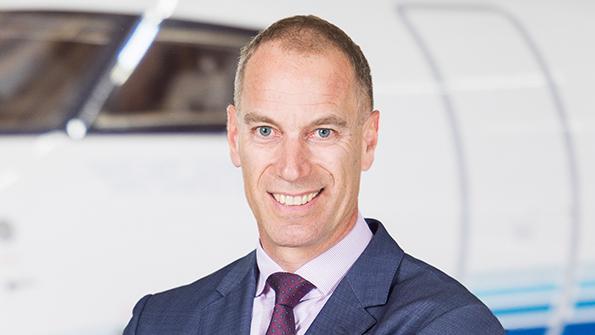
Markus Bucher.
Markus Bucher joined Switzerland’s Pilatus Aircraft more than 30 years ago. He was appointed to manage aircraft assembly and maintenance operations in 2008, became chief operating officer in 2011 and was promoted to CEO in 2013. He talked with ShowNews Editor-in-Chief Thierry Dubois.
AW&ST: In March, you reported supply chain problems. Has the situation improved? It was more of a shortage of raw materials, and that improved considerably. We still have supply chain challenges, and we are not producing the number of aircraft we had planned in 2023. At stake are on-time delivery and quality. It is too early to tell if we are seeing the light at the end of the tunnel.
On the PC-24 [business jet], the robustness of the supply chain has improved, and the production rate is close to our objective. On the PC-12 [turboprop], however, the output is up to 10% below target.
In 2023, we will deliver more than 40 PC-24s and close to a record of 100 PC-12s. Demand for the PC-12 was high, and it is even higher now.
The aerospace industry in Europe is struggling with recruitment. Are you easily filling open positions? We find enough candidates to fill open positions in general. We hire 2% of the applicants. Nevertheless, certain skill sets are difficult to find, such as in cybersecurity, specialized engineering and supply chain management. But Pilatus does not suffer from a general labor shortage.
Among your markets, where are the growth regions? With the PC-12, the typical geographical breakdown is unchanged, with two-thirds the Americas and one-third Europe and the rest of the world.
With the PC-24, the situation is slightly different. During the first five years, we sold aircraft in our typical areas. Then buyers in areas where single-engine aircraft get less traction expressed interest. In the Middle East and Asian countries such as India and Japan where flying over water is a requirement, we have found customers. The share of the Americas in the PC-24’s market is around 50%.
What’s next for the PC-24? What our customers tell us since the introduction of the Super Versatile Jet is they want more payload, range and cabin comfort. Over the past four years, we have worked on the next model. From the beginning of 2024 and Serial No. 501, the new model will offer more payload at an additional 600 lb. or more range at an extra 200-250 nm. We changed over 1,000 parts and saved a lot of weight. The new standard cannot be retrofitted.
When you enter the cabin, you will enjoy a new welcome center, a large divan where a tall person can lie flat and a new inflight entertainment system. We upgraded the overall cabin design.
Maintenance engineers will enjoy our predictive maintenance program. Because aircraft systems are fully digital, we can use a large quantity of data. Customers will be aware of unscheduled maintenance actions in advance.
Could you consider a stretched version of the PC-24? No. Pilatus builds aircraft that are fit for purpose. If we think of a longer fuselage, we design a new aircraft. We do not stretch aircraft.
How do you see business aircraft technology evolving until 2035? There is a lot of goodwill and capital spent on research for new propulsion systems. In reality, an electrical powertrain or a hydrogen aircraft have a long way to go. At Pilatus, as a first priority, we are trying to reduce fuel burn until new technologies arrive.
We believe in sustainable aviation fuel (SAF), not so much from biomass but rather synthetic fuels. A drop-in fuel is the best solution that our industry can find.
Given the slow ramp-up in SAF production, and the fact that several industries compete for such fuels, is it reasonable for business aviation to bet on heavily using SAF in the future? Absolutely. If we want to be carbon-neutral by 2050, the only way is SAF. Keep in mind, only 2% of the business aircraft fleet is replaced every year. Going electrical, hydrogen, etc. is mission impossible.
As an industry, we need to invest more in SAF, especially to produce synthetic fuel. We have to invest our own money, along with partners who are in the SAF business and countries that are in a favorable position to mass-produce SAF.
Why not make more publicity about the PC-12’s significantly lower CO2 emissions? The Swiss are humble people. We have a sustainability strategy based upon environmental, social and governance principles. We have been ISO14001-certified for more than 20 years.
As for CO2 emissions, customers do the comparison themselves. And this is part of the most recent success of the PC-12. People who would never have considered a turboprop are considering it now. We are not promoting that attribute further because we already cannot meet the demand for the PC-12. But customers do have a requirement for lower emissions and they let us to know.





